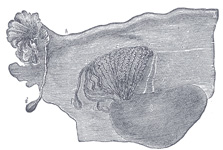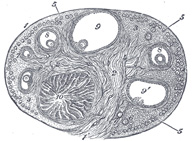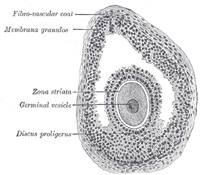(Ovaria)
The ovaries are homologous with the testes in the male. They are two nodular bodies, situated one on either side of the uterus in relation to the lateral wall of the pelvis, and attached to the back of the broad ligament of the uterus, behind and below the uterine tubes (Fig. 1161). The ovaries are of a grayish-pink color, and present either a smooth or a puckered uneven surface. They are each about 4 cm. in length, 2 cm. in width, and about 8 mm. in thickness, and weigh from 2 to 3.5 gm. Each ovary presents a lateral and a medial surface, an upper or tubal and a lower or uterine extremity, and an anterior or mesovarion and a posterior free border. It lies in a shallow depression, named the ovarian fossa, on the lateral wall of the pelvis; this fossa is bounded above by the external iliac vessels, in front by the obliterated umbilical artery, and behind by the ureter. The exact position of the ovary has been the subject of considerable difference of opinion, and the description here given applies to the ovary of the nulliparous woman. The ovary becomes displaced during the first pregnancy, and probably never again returns to its original position. In the erect posture the long axis of the ovary is vertical. The tubal extremity is near the external iliac vein; to it are attached the ovarian fimbria of the uterine tube and a fold of peritoneum, the suspensory ligament of the ovary, which is directed upward over the iliac vessels and contains the ovarian vessels. The uterine end is directed downward toward the pelvic floor, it is usually narrower than the tubal, and is attached to the lateral angle of the uterus, immediately behind the uterine tube, by a rounded cord termed the ligament of the ovary, which lies within the broad ligament and contains some non-striped, muscular fibers. The lateral surface is in contact with the parietal peritoneum, which lines the ovarian fossa; the medial surface is to a large extent covered by the fimbriated extremity of the uterine tube. The mesovarian border is straight and is directed toward the obliterated umbilical artery, and is attached to the back of the broad ligament by a short fold named the mesovarium. Between the two layers of this fold the bloodvessels and nerves pass to reach the hilum of the ovary. The free border is convex, and is directed toward the ureter. The uterine tube arches over the ovary, running upward in relation to its mesovarian border, then curving over its tubal pole, and finally passing downward on its free border and medial surface. | 1 |
 |
FIG. 1162– Adult ovary, epoöphoron, and uterine tube. (From Farre, after Kobelt.) a, a. Epoöphoron formed from the upper part of the Wolffian body. b. Remains of the uppermost tubes sometimes forming hydatids. c. Middle set of tubes. d. Some lower atrophied tubes. e. Atrophied remains of the Wolffian duct. f. The terminal bulb or hydatid. h. The uterine tube. i. Hydatid attached to the extremity. l. The ovary. (See enlarged image) |
| |
| |
| Epoöphoron (parovarium; organ of Rosenmüller) (Figs. 1161, 1162).—The epoöphoron lies in the mesosalpinx between the ovary and the uterine tube, and consists of a few short tubules (ductuli transversi) which converge toward the ovary while their opposite ends open into a rudimentary duct, the ductus longitudinalis epoöphori (duct of Gärtner). | 2 |
| |
| Paroöphoron.—The paroöphoron consists of a few scattered rudimentary tubules, best seen in the child, situated in the broad ligament between the epoöphoron and the uterus. | 3 |
| The ductuli transversi of the epoophoron and the tubules of the paroophoron are remnants of the tubules of the Wolffian body or mesonephros; the ductus longitudinalis epoöphori is a persistent portion of the Wolffian duct. | 4 |
| In the fetus the ovaries are situated, like the testes, in the lumbar region, near the kidneys, but they gradually descend into the pelvis (page 1211). | 5 |
 |
FIG. 1163– Section of the ovary. (After Schrön.) 1. Outer covering. 1’. Attached border. 2. Central stroma. 3. Peripheral stroma. 4. Bloodvessels. 5. Vesicular follicles in their earliest stage. 6, 7, 8. More advanced follicles. 9. An almost mature follicle. 9’. Follicle from which the ovum has escaped. 10. Corpus luteum. (See enlarged image) |
| |
| |
| Structure (Fig. 1163).—The surface of the ovary is covered by a layer of columnar cells which constitutes the germinal epithelium of Waldeyer. This epithelium gives to the ovary a dull gray color as compared with the shining smoothness of the peritoneum; and the transition between the squamous epithelium of the peritoneum and the columnar cells which cover the ovary is usually marked by a line around the anterior border of the ovary. The ovary consists of a number of vesicular ovarian follicles imbedded in the meshes of a stroma or frame-work. | 6 |
| The stroma is a peculiar soft tissue, abundantly supplied with bloodvessels, consisting for the most part of spindle-shaped cells with a small amount of ordinary connective tissue. These cells have been regarded by some anatomists as unstriped muscle cells, which, indeed, they most resemble; by others as connective-tissue cells. On the surface of the organ this tissue is much condensed, and forms a layer (tunica albuginea) composed of short connective-tissue fibers, with fusiform cells between them. The stroma of the ovary may contain interstitial cells resembling those of the testis. | 7 |
| |
| Vesicular Ovarian Follicles (Graafian follicles).—Upon making a section of an ovary, numerous round transparent vesicles of various sizes are to be seen; they are the follicles, or ovisacs containing the ova. Immediately beneath the superficial covering is a layer of stroma, in which are a large number of minute vesicles, of uniform size, about 0.25 mm. in diameter. These are the follicles in their earliest condition, and the layer where they are found has been termed the cortical layer. They are especially numerous in the ovary of the young child. After puberty, and during the whole of the child-bearing period, large and mature, or almost mature follicles are also found in the cortical layer in small numbers, and also “corpora lutea,” the remains of follicles which have burst and are undergoing atrophy and absorption. Beneath this superficial stratum, other large and more or less mature follicles are found imbedded in the ovarian stroma. These increase in size as they recede from the surface toward a highly vascular stroma in the center of the organ, termed the medullary substance (zona vasculosa of Waldeyer). This stroma forms the tissue of the hilum by which the ovary is attached, and through which the bloodvessels enter: it does not contain any follicles. | 8 |
| The larger follicles (Fig. 1164) consist of an external fibrovascular coat, connected with the surrounding stroma of the ovary by a net-work of bloodvessels; and an internal coat, which consists of several layers of nucleated cells, called the membrana granulosa. At one part of the mature follicle the cells of the membrana granulosa are collected into a mass which projects into the cavity of the follicle. This is termed the discus proligerus, and in it the ovum is imbedded. 179 The follicle contains a transparent albuminous fluid. | 9 |
| The development and maturation of the follicles and ova continue uninterruptedly from puberty to the end of the fruitful period of woman’s life, while their formation commences before birth. Before puberty the ovaries are small and the follicles contained in them are disposed in a comparatively thick layer in the cortical substance; here they present the appearance of a large number of minute closed vesicles, constituting the early condition of the follicles; many, however, never attain full development, but shrink and disappear. At puberty the ovaries enlarge and become more vascular, the follicles are developed in greater abundance, and their ova are capable of fecundation. | 10 |
 |
FIG. 1164– Section of vesicular ovarian follicle of cat. X 50. (See enlarged image) |
| |
| |
| Discharge of the Ovum.—The follicles, after attaining a certain stage of development, gradually approach the surface of the ovary and burst; the ovum and fluid contents of the follicle are liberated on the exterior of the ovary, and carried into the uterine tube by currents set up by the movements of the cilia covering the mucous membrane of the fimbriæ. | 11 |
| |
| Corpus Luteum.—After the discharge of the ovum the lining of the follicle is thrown into folds, and vascular processes grow inward from the surrounding tissue. In this way the space is filled up and the corpus luteum formed. It consists at first of a radial arrangement of yellow cells with bloodvessels and lymphatic spaces, and later it merges with the surrounding stroma. | 12 |
| |
| Vessels and Nerves.—The arteries of the ovaries and uterine tubes are the ovarian from the aorta. Each anastomoses freely in the mesosalpinx, with the uterine artery, giving some branches to the uterine tube, and others which traverse the mesovarium and enter the hilum of the ovary. The veins emerge from the hilum in the form of a plexus, the pampiniform plexus; the ovarian vein is formed from this plexus, and leaves the pelvis in company with the artery. The nerves are derived from the hypogastric or pelvic plexus, and from the ovarian plexus, the uterine tube receiving a branch from one of the uterine nerves. | 13 |


